|
|
 |
|
|
|
 |
 |
|
|
 |
What happens at a climate summit?
A report from the meeting in Montreal in November 2005
All nations on our planet share the climate system, with clouds, wind systems and pollution crossing all borders. It is not easy to agree on how to protect the climate around the world especialy since the various nations try to look after their own interests.
|
 |
 |
|
1. Flags at the United Nations building, adapted from an original © Norman Walsh, Creative Commons Licence
|
|
Therefore, the outcomes of a climate conference in which nearly 200 nations have to agree on common rules are often very formal. The following report concerns the discussion and outcomes during the climate summit in November 2005 in Montreal. It will help us to understand how decisions are made and what the experts from science, policy and economics discuss.
|
 History History
Air pollution and other environmental dangers caused by humans have been observed for centuries. But the history of the international discussion of climate change is rather young. In 1992 (related to the so called "Earth summit" in Rio de Janeiro) the United Nations Framework Convention on Climate Change (UNFCCC) was adopted.
|
 |
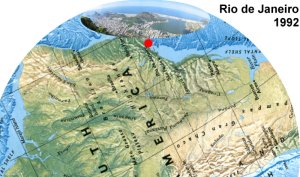 |
 |
|
2. The first important "Earth summit" took place in Rio de Janeiro / Brazil in 1992.
|
|
 |
 |
|
3. UNFCCC logo
Visit the UNFCCC website by clicking on the logo.
|
|
 |
The main goal of the UNFCCC is to avoid greenhouse gas emission going beyond a level which is dangerous for humans and the climate system. The 189 parties (parties here usually means countries) of the UNFCCC meet now about once a year at the so-called conference of the parties (COP) of the UNFCCC.
The third conference of the parties (COP 3) was one of the most famous. It took place in December 1997 in Kyoto. Here, the more developed and industrialised countries agreed to measures which would reduce the emissions of six greenhouse gases to a level 5.2% below the level of 1990.
|
This level should be achieved between 2008 and 2012. This was the famous Kyoto Protocol, which was, however, not immediately accepted. The process of formal acceptance by a government is called “ratification”.** The Kyoto Protocol finally came into force after Russia ratified it in February 2005. The protocol defined certain targets of how much each single country in the protocol can emit. It introduced a system of emission trading* and a so called Clean Development Mechanism (CDM).
|
 |
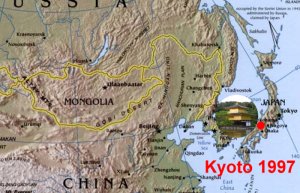 |
 |
|
4. The COP 3 took place in Kyoto / Japan in 1997.
|
|
|
A major problem for the future is that the developing countries, including also large countries like China and India, do not participate in the Kyoto process. The emissions of developing countries are much lower than those of industrialized countries. However, some of them are showing strong economic growth and also strongly increasing emissions.
|
|
|
 |
7. The countries shown in green have signed and ratified the protocol. State: Nov 2005. For a topical list of the state of signature and ratification see the UNFCCC Kyoto website.
|
|
This leads to the question, how should developing countries be included into binding reduction mechanisms after 2012. Another problem is that the United States of America, the world’s largest emitter of greenhouse gases, has not ratified the Kyoto Protocol. In any case, this protocol can only be a first step and much more drastic reductions of greenhouse gases are urgently required now and in the near future.
|
* Emission trading is when one company which emits more than permitted can buy further permits for emission from another company which emits less than permitted. This is shown in the scheme on the right.
** Ratification is the process of adopting an international treaty, or a constitution or other nationally binding document (such as an amendment to a constitution) by the agreement of multiple subnational entities.
|
 |
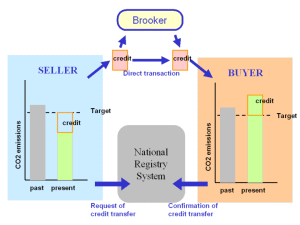 |
 |
|
8. Scheme: emission trading; © Elmar Uherek
Please click to enlarge.
|
|
|
In this situation the COP 11 conference in Montreal took place. Here is what happened:
 Agreement on measures Agreement on measures
The agreement on measures for a cleaner environment is a long term process. Such measures make changes necessary in national policy, laws and the economy. Therefore the representatives in a climate summit cannot just make a major decision, but measures are often discussed over months and years in so called subsidiary groups and decided during one of the following climate summits. If new measures are major changes or extensions of previous decisions, an amendment can be necessary, which has to be ratified or accepted by all signing governments, like the Kyoto Protocol. This can take a long time.
|
During the Montreal summit all parties decided to adopt an implementation program which describes in concrete guidelines how to organise and facilitate the realisation of the Kyoto protocol. The guidelines had already been developed during the climate summit in 2001 in Marrakesh. They have become relevant now since in February 2005 the Kyoto Protocol came into force.
Saudi Arabia considered insisting on an amendment for these so called “Marrakesh Accords”. But after some negotiations the other parties convinced Saudi Arabia to adopt the guidelines by a decision of the Conference of the Parties (COP) and to think over an amendment later. So a lot of time was saved.
|
 |
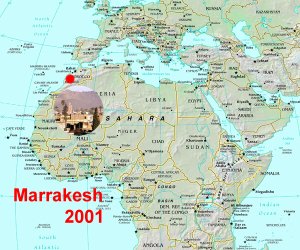 |
 |
|
9. Decisions for Montreal had been prepared in Marrakesh.
|
|
|
 What are the "Marrakesh accords" about? Here a few illustrations ... What are the "Marrakesh accords" about? Here a few illustrations ...
Click the schemes to enlarge them. (fig 10. a - d) |
|
Focus: Technology transfer
The Marrakesh accords explain how to form expert groups for technology transfer from all fields and continents.
|
 |
Focus: finances
The Marrakesh accords give guidelines for the administration and flow of money under the UNFCCC programs.
|
|
Focus: administration and organisation
The "Marrakesh accords" make suggestions for the set up of national offices and their interaction with UNFCCC headquarters and local environmental organisations in the country where the office is located.
|
 |
Focus: education and training
The "Marrakesh accords" describe how to organise training and education for the environment in particular in developing countries.
|
|
 Definition of tasks Definition of tasks
The parties under the United Nations Framework Convention on Climate Change have to decide which actions should be considered and carried out. Historically the focus of UNFCCC was on greenhouse gases, gases which make the lower atmosphere warmer. But in the climate system many things are interlinked and the COP needs to decide on the main targets of the program (for example: emission trading, tree planting, promotion of public transport, waste management, bio-fuels, etc.). New options may arise with research efforts.
|
Example: It can be useful to separate the greenhouse gas carbon dioxide (CO2) in power plants from other combustion gases and to store it in caves and geologically locked layers under the ground. From here the gas cannot escape back to the air and would not enhance the greenhouse effect. This process is known as “carbon storage”. But separation and pumping it down is very energy intensive. Therefore it is only reasonable under certain conditions. The UNFCCC parties are now considering whether such efforts should be supported.
|
 |
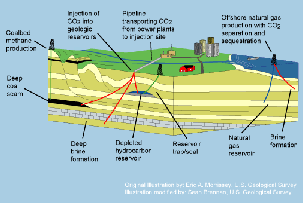 |
 |
|
11. Options for carbon storage, scheme: USGS - Please click to enlarge.
|
|
Other problems are well known but not yet included in the UNFCCC agenda:
Papua New Guinea and Costa Rica, supported by other countries, suggested in Montreal including an agenda item on “reducing emissions from deforestation in developing countries.” Papua New Guinea has suggested providing incentives to developing countries for avoiding deforestation.
|
|
 Funds Funds
Many environmental protection measures cost money – for example: filters, separation techniques, energy efficient power plants, controlling administration, etc. In particular the poorer countries cannot afford investments. Therefore, developing countries can apply for monetary support, for example if they would like to install a plant for the production of bio-fuel which would be more expensive than to import ordinary fuel.
The money has to come from other countries and is administered in several funds. Some money comes from the Global Environment Facility (GEF). The GEF helps developing countries fund projects and programmes that protect the global environment. You can learn more about the GEF on the Internet at http://www.undp.org/gef/05/ and about its small grants program at http://sgp.undp.org/ .
Since the conditions of the GEF are not always flexible, several other special funds have been discussed. For example, a fund for the least developed countries was adopted. But a more flexible special fund on climate change was discussed in one work group again in Montreal without any concrete results about what should be included.
|
|
 Financial problems Financial problems
As you maybe know from the evening news, many industrialised and rich countries in the world complain about debts, high unemployment and not enough money for the government.
|
Therefore, it is not easy to get the money for such funds and to share it in a fair way. Debates on the financial issues take a long time and are not always successful. This is why the governments will happily sign agreements if the commitment is only voluntary (like after the climate summit of Rio in 1992), but are very careful if concrete measures and punishments in the case of non-fulfillment are announced as in the Kyoto Protocol.
Sometimes it is also difficult for the UNFCCC to get the money which has already been pledged before. Some countries were behind with payments and had to be reminded in Montreal.
16. Organisation of environmental programmes costs money: Here are the GEF administration costs as part of the total budget in million US dollar.
|
 |
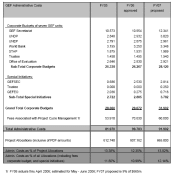 |
 |
|
Source: GEF
Please click to enlarge.
|
|
 |
 |
|
17. Solar thermal tower with an updraft wind turbine. Pilot project in Manzanares (Spain). The development and testing of new technologies is costly for the investing companies. They need to gain the money back by selling the technology if it is successful.
Please click the photo for a larger view. (100 K)
|
|
 |
 Technology transfer Technology transfer
Another financial or economic problem is related to new technologies. Some countries have invested in research and are developing advanced technologies, for example in the energy sector (renewable energies, more efficient power plants, etc.). On the world market, companies usually sell their products in order to cover the costs of development and pay the employees. On the other hand, advanced technologies for prevention of climate change are urgently needed in many countries which cannot afford to buy them. So, there are conflicts of how to transfer technology without affecting the rules of the market and property rights. This was discussed in Montreal.
For example, China stressed the need to overcome tax, intellectual property and other barriers.
|
|
 Control of actions Control of actions
Even if funds are available, regulations are necessary concerning how the money is spent. In the past, some programs proved to be unsuccessful, badly planned or dominated by the interests of certain groups. Therefore, care must be taken when deciding which projects are selected.
For example, a work programme developed in Buenos Aires on adaptation and response measures was to be started up. All parties agreed that the work programme was needed, but discussions in Montreal revealed that it is more difficult to agree on specific activities.
The G77/China (developing countries) called for a bottom-up approach. This means administration should be reduced and countries can more easily put their spontaneous ideas into practice. But this was opposed by the US, Canada, the EU and others, who voted for the establishment of an expert group. In the end, the parties could not agree on a final text, but handed the task over to a future meeting of the Subsidiary Body for Scientific and Technological Advice (SBSTA).
|
|
 Adaptation Adaptation
While measures are being discussed, time goes by and emissions remain the same, increase or are only slightly reduced. Consequently, climate change is already taking place or cannot be avoided anymore to some extent. The experts are aware of this and many countries have started to think about what to do when living conditions have changed: for example, more floods, longer drought periods or other extreme weather events.
|
Mauritius spoke for the Alliance of Small Island States. They want early warning systems to be developed in order to reduce the impacts of extreme weather events.
For other regions in the world, drought monitoring systems should be established in order to give early recommendations to farmers.
Bangladesh, one of the least developed countries but heavily threatened by the rising sea level, called for compensation for damages caused by climate change.
Also, a Special Adaptation Fund (already suggested in Marrakesh) was discussed again. It is a general question for the UNFCCC whether there should be a stronger focus on adaptation, because the program was originally started in order to avoid climate change and not to cope with its consequences.
|
 |
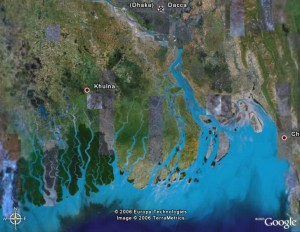 |
 |
|
19. Bangladesh is land between water. The country has 140 million inhabitants and is one of the densliest populated in the world. It is regulary affected by floods with thousands of people killed and hundreds of thousands made homeless.
Source: Google Earth - Please click the photo to enlarge. (110 KB)
|
|
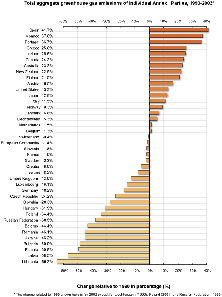 |
 |
|
20. Change in greenhouse gas emissions from 2002 compared to 1990 for the Annex I countries. The downward trend for some countries is based to some extent on the end of the commnist era with many factories closing. In recent years, however, emissions are slightly increasing again. Most developing countries show a relatively strong upward trend.
|
|
 |
 Beyond 2012 Beyond 2012
One of the most sensitive issues is how the parties (countries) will engage on commitments to combat climate change after 2012. The Kyoto Protocol defined in 1997 what should be achieved by 2012. But it took until 2005 before at least 55% of the countries causing more than 55% of the emissions ratified this protocol. Governments are very careful about making promises beyond 2012 although everybody knows that much more has to be done than defined in the Kyoto Protocol. Long discussions took place in Montreal about how to start thinking about this time. For example, the organization of work groups was discussed.
Japan mentioned that emissions in non-Annex I countries which were not included in the Kyoto process, are growing rapidly. Therefore the UNFCCC would require a review and a new framework for taking action.
For the future, the suggestions range from an ad hoc working group suggested by China to a world climate summit suggested by Tuvalu.
|
|
 Conclusions Conclusions
Considering the continuing climate change which is already observable, such as the ice melting in the Arctic, we could get the impression that the reaction of those responsible is unbelievably slow. Certainly there are many ideas and programmes available proposing more drastic and faster changes in the global economy. However, when it comes to concrete negotiations among all countries in the world, they are not suitable for a compromise. Each nation decides independently and guidelines cannot be adopted by a majority expecting that all other nations are going to follow. In the end, concerns about present economy and other national interests of a country are often stronger than the worries about future climate change.
This does not mean that single countries or groups of countries cannot and do not go much further, but it is very difficult to achieve quick progress in global agreements followed by all countries in the world.
|
|
 |
|







